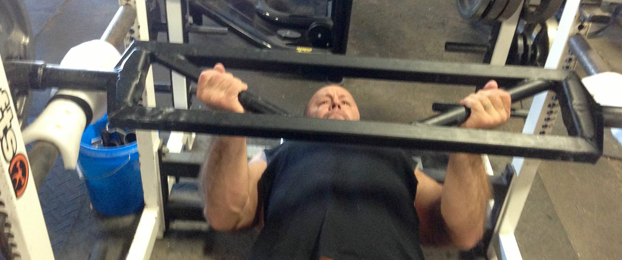
The last five years of my life have seen significant changes, the least of which has been my body weight. This “little” change has led to much larger ones in my training. Keeping up with the Joneses takes on a whole new meaning when you’re trying to bench with guys who outweigh you by 50 pounds or more. As the saying goes, weight moves weight. I’ve discovered that with some alterations I’ve been able to keep my bench in a much higher range than normally expected for a 175-lb person. Here’s how…
Technique
I know…you know how to bench. I did too, but when your chest (and gut) is now several inches smaller, the bar keeps coming down a bit further. To compensate for this, my technique had to change. I still do the whole scapula together, pull the bar apart, and push the feet thing, but I’ve had to concentrate on two things:
- Keep your weight on your traps. Louie Simmons was always yelling this, but I didn’t really understand until I had less body weight to compensate for not doing this. As you position yourself, try to make the main point of contact the upper trap muscles into the neck. You will have to really push the arch and make a conscious effort to keep the hips down. A great technique that Power B came up with is to put a rope with a weight tied to it under the hips. If you don’t keep pressure, the rope falls and you know your hips came up. Keeping the weight on your traps allows you to push the bar toward the feet and keeps it in your power plane. I noticed that at a lighter body weight, it’s much easier to allow the bar to drift toward the head out of the proper range.
- Pull your scapula down. We all know to pull the scapula together when benching. I now need to also pull them toward the waist during the set-up as well. This helps with keeping the weight on my traps and in pulling the bar apart. You have to do it to know exactly what I’m talking about, but when you do, you’ll know it. You feel very tight, and the bar feels like it has more spring at the bottom.
Exercise choice
I don’t use a bench shirt to train in. I’ve left powerlifting competition so training in one doesn’t help my actual strength. Because of this, I’ve had to change my exercise selection slightly. When competing, I had little need to do many full motions because the shirt would take care of the first few inches. Now, I have to do it.
I again turned to the advice of Power B. He had started using a full motion one week and then a partial the next to save wear and tear on his shoulders. I found the technique to work equally well on improving a non-shirt bench because you get the benefits of full training and the overload of partial without your shoulders and pecs ripping out.
I’ve also limited the number of exercises that I perform. I like to perform a max effort movement followed by another barbell motion. A higher rep barbell motion or other press follows. Then, I do some direct triceps work and a set or two for my back for a total of about five exercises. I train the bench once per week. I found that using three pressing motions, even repping, needs at least a week of recovery.
Diet
I won’t really go into a full discussion on diet, but I’ve found some guidelines that help lighter guys keep their strength moving up.
High protein: Healthy or not, needed or not, I found that 250–300 grams of protein with no refined carb sources (to keep calories under control) really benefits my strength levels.
Post-workout shake: I drink a shake with about 80 grams of protein, some frozen fruit, oatmeal, and water immediately after training. Then, I have another shake without the oatmeal about 1.5 hours later. This helps my recovery immensely.
Food choices: My food choices include fruit, fibrous vegetables, limited complex unrefined carbs, lean meat, and liberal use of canola and extra virgin olive oil. I’ve found this base to be perfect for keeping me lean and healthy (explained in-depth in the The Paleo Diet by Loren Cordain, Ph.D.). A healthy athlete recovers better and is stronger.
I don’t want to weigh 275 lbs on a five-foot, eight-inch frame and bench 650 lbs because I’d look like I should be a contestant on the Biggest Loser. I’d rather weigh 175 lbs, be able to take my shirt off at the beach and not be harpooned, bench a legit 350 lbs without a shirt, and keep working my ass off to be stronger. If this violates the current powerlifting creed, so be it. If looking lean and being strong at the bench appeals to you, try these simple tips and see what happens.
I’ve listed my last bench workout below to show how I’ve put my ideas to work:
Max Effort:
- 2-board with monster minis, worked up to 305 lbs, got 315 lbs but raised my hips
- medium grip beekers followed by 10 reps off 3-boards, 275 lbs, had to rest twice during last 10 reps
- low incline, 1.5 reps tri-setted with incline flies and push-downs, 225 lbs on incline for 3–1.5 reps, 60-lb flies for 5 reps, stack (230 lbs) for 5 reps on push-downs (put this cycle in for fun to see how it would work; not bad for something different)
- machine back rows, set of 5 with drop, supersetted with barbell curl with strip
- hang clean and press, 155 lbs/7








